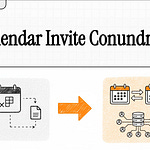1. What is the fundamental problem with traditional email campaigns for event invitations?
Traditional email campaigns for event invitations are largely ineffective because they are a broadcast method in a "digital ocean of notifications." Despite masterful crafting, emails often disappear into the ether due to the sheer volume of over 300 billion emails sent daily. This results in extremely low conversion rates (e.g., 2.5%), indicating that the vast majority of effort and valuable offers fail to reach their intended audience or prompt the desired action. The email inbox is identified as an "un-prioritized repository" and a "digital equivalent of a public square where everyone is shouting at once," making it an unsuitable tool for managing time commitments.
2. How does the "Invite First" philosophy propose to solve this problem?
The "Invite First" philosophy proposes to solve this problem by leveraging the calendar invite as the primary tool for securing time commitments. Instead of sending an email that requires a "cascade of actions" (read, click, fill form, find time, confirm), the calendar invite "short-circuits this entire process" by placing the time block and RSVP directly where time decisions are made. It shifts from a broadcast model to an intention-driven approach, where the invite itself is a "commitment" rather than merely a suggestion or a file to download.
3. What is the key distinction between a generic "Add to Calendar" download and a sent calendar invite?
The key distinction is that a generic "Add to Calendar" download is merely a "note" or a "file," while a sent calendar invite represents a "commitment." A sent invite carries the crucial functionalities of RSVP, updates, and accountability, making it a dynamic record of an event. In contrast, a download is static and lacks the integrated features that manage the event's lifecycle and facilitate genuine time alignment between parties.
4. How does a calendar invite function as a "three-dimensional record" that manages an event's entire lifecycle?
A calendar invite functions as a "three-dimensional record" by managing an event's lifecycle across three phases:
Before the event: It acts as a personal assistant, with acceptance signaling intent and built-in reminders firing automatically. Details can be updated once and propagate everywhere, ensuring the invitee has current information without needing to check emails or websites.
During the event, it serves as a central hub, containing all necessary information like location, meeting links, and agenda, accessible with "one click."
After the event, it becomes a historical record, logging what happened, when, and with whom. It anchors notes, follow-ups, and subsequent actions, preventing momentum loss.
5. What are the immediate and profound results observed when shifting to the "Invite First" approach?
The immediate and profound results observed when shifting to the "Invite First" approach include a significant increase in show-up rates and actual attendance. This is because time is no longer spent chasing stragglers or sending last-minute reminders, as the system handles these tasks. Consequently, the inviter's time is "invested in the event itself," leading to a transition from "broadcasting" to "connecting."
6. Why is the calendar invite considered the "compass of time" and a needle pointing to commitment?
The calendar invite is considered the "compass of time" and a needle pointing to commitment because it is the fundamental tool designed specifically for managing and aligning time. It transcends simple scheduling, embodying the philosophy that "Your time matters, and I am a steward of it." By placing an event directly on someone's calendar, it signifies a shared intention and a solid commitment, unlike the passive and often ignored nature of email.
7. How does using calendar invites reclaim both the inviter's and the invitee's time?
Using calendar invites reclaims time for both parties by streamlining the process and reducing cognitive load. For the inviter, it eliminates the need to create complex email campaigns, chase RSVPs, or send manual reminders, freeing up time to focus on the event itself. For the invitee, it eliminates the "digital obstacle course" of clicking links, filling out forms, and confirming times, ensuring that important event details and reminders are automatically stored in the one tool they trust for managing their day, thus respecting their time and reducing distractions.
8. What does the "Invite First" strategy advocate for the overarching philosophical shift?
The overarching philosophical shift advocated by the "Invite First" strategy is moving from a system "built on hope, not commitment" to one that prioritizes mutual respect for time and clear intention. It's a shift from merely "broadcasting" information and "shouting into the void" of inboxes to actively "connecting" through a dedicated channel built for commitment. This empowers individuals to be "in control" of their time, making the clock work for them rather than against them.






